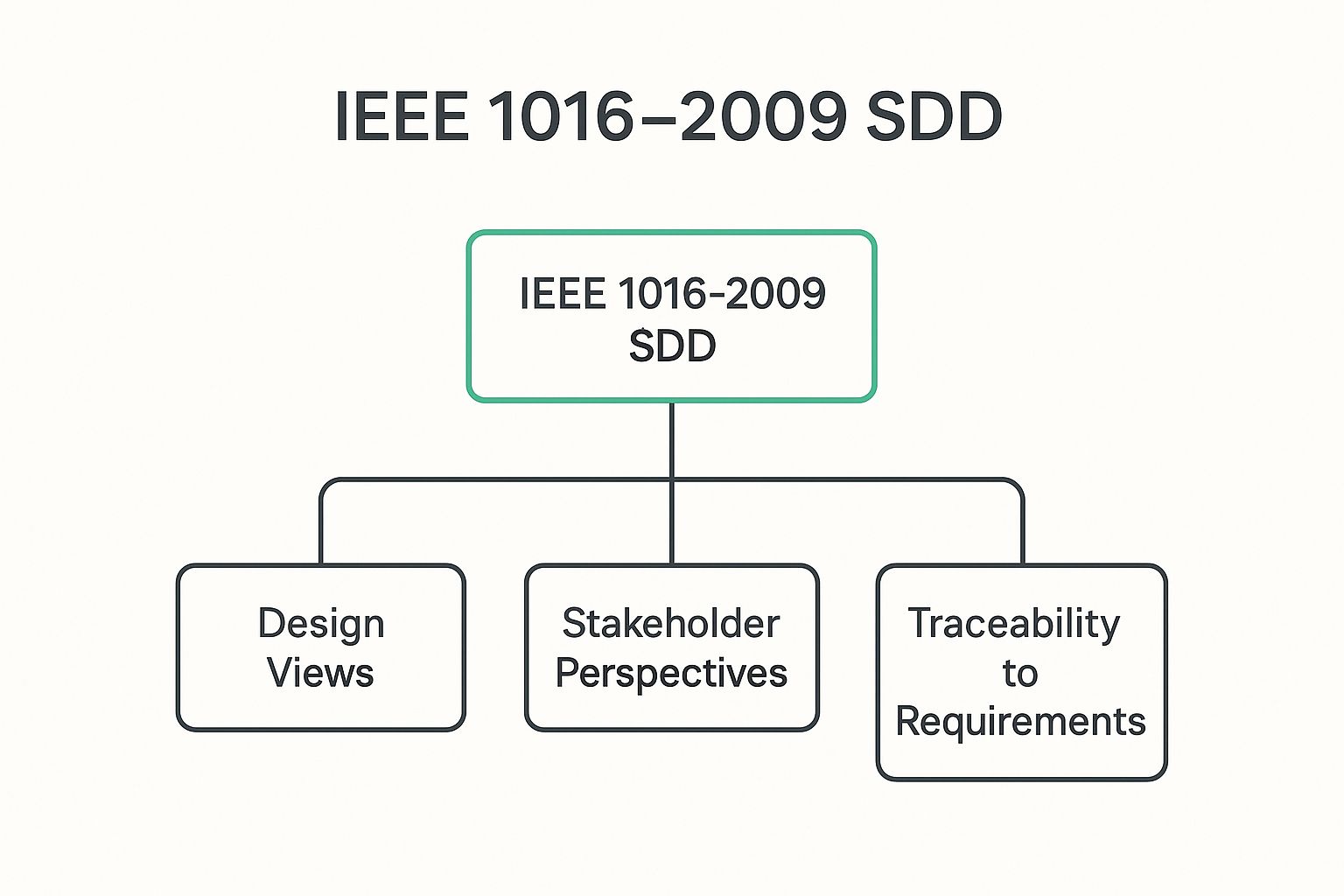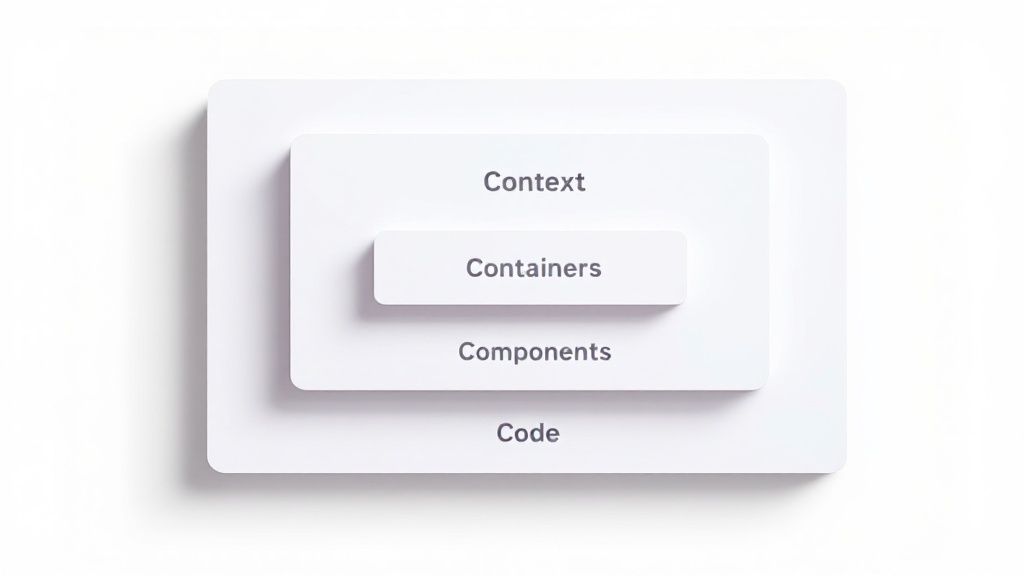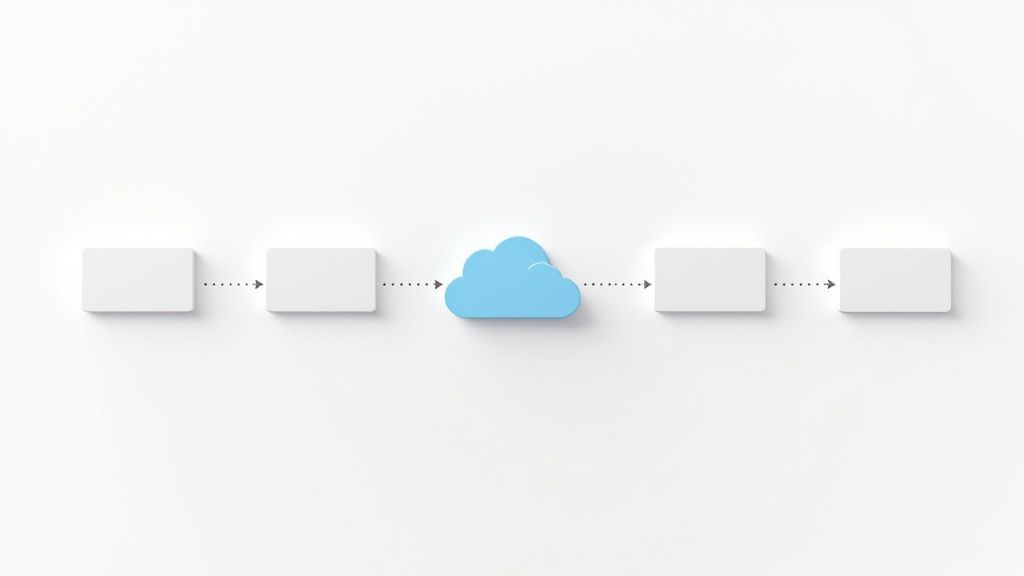Explore 6 detailed software design description sample frameworks. Learn to apply IEEE 1016, C4, DDD, and more with expert analysis and actionable tips.
A well-crafted Software Design Description (SDD) is the architectural blueprint of any robust software system. It is more than just a document; it is a critical communication tool that aligns stakeholders, guides developers, and ensures the final product meets its intended requirements. Without a clear and comprehensive SDD, projects often suffer from miscommunication, scope creep, and technical debt, ultimately leading to costly rework and delays.
Creating an effective SDD, however, can be a significant challenge. Teams often struggle with determining the right level of detail, choosing an appropriate structure, and ensuring the document remains a living, useful asset rather than a static artifact. This guide demystifies the process by presenting six distinct and powerful software design description sample frameworks. From the rigorous IEEE standard to the agility of the C4 model and the strategic focus of Domain-Driven Design, we will dissect each one with a focus on practical application.
Our analysis will move beyond surface-level templates. For each example, we will provide a deep strategic breakdown, tactical insights, and replicable methods you can immediately apply to your own projects. Understanding these patterns requires a solid grasp of core architectural principles, as a strong foundation in System Design Fundamentals is crucial for creating or interpreting high-impact software design descriptions. Whether you’re building a complex enterprise system or a nimble microservices application, these examples will equip you with the knowledge to document your designs with clarity, precision, and strategic intent. Ready to transform your documentation from a tedious task into a powerful project accelerator? Let DocuWriter.ai help you generate, manage, and scale your technical documentation with ease.
The IEEE 1016-2009 standard stands as a cornerstone for formal software engineering, providing a comprehensive and universally recognized framework for creating a Software Design Description (SDD). It’s not just a template; it’s a structured methodology for documenting the architecture and design of a software system. This standard earns its top spot due to its rigor, completeness, and widespread adoption in high-stakes industries where clarity and precision are non-negotiable.
This approach organizes the design into a series of stakeholder-oriented design views. Instead of one monolithic document, the standard encourages creating multiple perspectives, each tailored to a specific concern (e.g., a data view for database administrators, a deployment view for DevOps). This ensures that every stakeholder, from developers to project managers, can understand the parts of the design most relevant to them. The standard defines the necessary content, structure, and format, promoting consistency and making the SDD an authoritative reference throughout the software lifecycle.
The core strength of the IEEE 1016 standard lies in its structured approach to capturing complex design decisions. It forces teams to think critically about how different system components will interact and how the design fulfills specific requirements.
This infographic visualizes the standard’s core hierarchical structure, showing how it connects stakeholder needs to the final design.

The visualization highlights that stakeholder perspectives directly influence the creation of specific design views, all of which must maintain clear traceability back to the initial requirements.
While the full standard can seem daunting, you can adapt its principles for projects of any size.
For a deeper dive into structuring your documents, explore this comprehensive software design description sample that builds on these foundational concepts. By adopting the discipline of IEEE 1016, your team can produce robust, maintainable, and well-understood software systems.
Tired of manually creating and updating complex software design descriptions? DocuWriter.ai can automate the process, ensuring your documentation is always accurate, comprehensive, and compliant with standards like IEEE 1016.
The C4 model offers a refreshing, pragmatic approach to software architecture documentation, prioritizing clarity and communication over exhaustive detail. Developed by Simon Brown, it’s a graphical notation technique designed to create a set of simple, hierarchical diagrams that tell the story of a software system. Its position on this list is earned by its accessibility, making complex architectural concepts understandable to a wide audience, from developers to business stakeholders.
Instead of a single, overwhelmingly complex diagram, the C4 model breaks down the architecture into four distinct levels of abstraction: System Context, Containers, Components, and Code. This layered approach allows you to zoom in and out of the system design, providing the right level of detail for any given conversation. The C4 model isn’t a replacement for UML; it’s a map-making tool for your codebase, guiding viewers from a high-level landscape down to the specific streets and buildings.

The C4 model’s power comes from its structured narrative, which makes architecture a collaborative process rather than a top-down mandate. It helps teams build a shared understanding by focusing on the static structure and key interactions within the software.
This visualization shows how each C4 level provides a more granular view, enabling a comprehensive understanding of the system’s architecture without overwhelming the audience.
Adopting the C4 model doesn’t require a massive upfront investment. Its simplicity is its greatest feature, and you can start applying its principles immediately to improve your design documentation.
By leveraging the C4 model, you can create a software design description that is both informative and accessible, fostering better alignment and collaboration across your entire organization.
Want to generate C4 model diagrams automatically from your codebase? DocuWriter.ai simplifies architecture visualization, keeping your documentation perfectly in sync with your evolving system.
The Domain-Driven Design (DDD) documentation pattern shifts the focus from purely technical specifications to modeling the core business domain itself. It’s not a rigid template but a strategic approach where the documentation captures the business language, rules, and structures that directly influence the software’s architecture. This pattern earns its place by creating a living document that aligns technical implementation with business reality, ensuring the software solves the right problems in a way that makes sense to domain experts.
This approach centers on creating a Ubiquitous Language - a shared, unambiguous vocabulary used by developers, domain experts, and stakeholders. The documentation’s primary goal is to define and preserve this language. It meticulously maps out Bounded Contexts (distinct areas of the business model) and the Domain Model (the objects, events, and rules within each context). This makes the software design description sample a direct reflection of the business logic, rather than an abstract technical blueprint.
The strength of DDD documentation lies in its ability to manage complexity by breaking down a large business domain into smaller, more manageable models. It forces a deep collaboration between technical teams and business experts, ensuring the final product is a true representation of business needs.
While DDD can seem theoretical, its documentation principles are highly practical and can be adapted to improve clarity on any project with significant business rules.
By adopting a DDD approach for your documentation, you create a powerful software design description sample that not only guides development but also serves as a lasting repository of business knowledge.
Struggling to keep your technical documentation aligned with complex business logic? DocuWriter.ai helps you generate and maintain DDD artifacts, ensuring your software design description is a perfect reflection of your domain.
Microservices architecture design documentation addresses the unique challenges of describing a distributed system composed of small, independent, and loosely coupled services. Unlike monolithic applications, where design can be captured in a single document, a microservices SDD must articulate service boundaries, communication protocols, and data management strategies across a complex ecosystem. It ranks highly on this list because it represents a modern, essential approach to documenting the highly scalable and resilient systems powering today’s digital economy.
This documentation style focuses on both the individual service and the system as a whole. Each microservice often has its own lightweight design document, while system-level documentation captures cross-cutting concerns like service discovery, API gateways, and distributed tracing. This dual focus ensures that individual development teams can operate autonomously while maintaining a cohesive and predictable system architecture. The goal is to provide a clear map of a system that is, by nature, decentralized and constantly evolving.

This diagram visualizes how independent services interact, highlighting the need for documentation that clarifies API contracts and data flows between them.
The strength of a microservices SDD lies in its ability to manage complexity at scale. It forces teams to explicitly define service responsibilities and interfaces, which is critical for preventing chaos in a distributed environment. This documentation becomes the “source of truth” for how services interact.
Adopting a microservices documentation strategy requires a shift from traditional, centralized documentation to a more federated model.
For a deeper analysis of this design style, explore these powerful microservices architecture patterns. By embracing this distributed documentation model, your teams can build and manage complex systems with clarity and confidence.
Keep your microservices documentation from becoming a tangled mess. DocuWriter.ai automatically maps service dependencies and generates up-to-date API documentation, bringing clarity to your distributed system.
Clean Architecture, popularized by Robert C. Martin (“Uncle Bob”), provides a powerful philosophy for structuring software that prioritizes maintainability and testability. The corresponding design documentation focuses on clearly defining concentric layers of the system, governed by a strict dependency rule. This architectural style earns its spot on this list for its elegant solution to coupling, ensuring that core business logic remains independent of external concerns like databases, web frameworks, and UI.
The documentation model centers on visualizing the system as a series of circles. The innermost circle contains the enterprise-wide business rules (Entities), surrounded by a layer for application-specific business rules (Use Cases). Further out are the interface adapters (Controllers, Presenters) and, finally, the outermost layer for frameworks and drivers (UI, Database, Web). The core principle is that dependencies can only point inward, making the business logic completely unaware of the implementation details of the outer layers.
The strength of a Clean Architecture SDD is its focus on enforcing boundaries and separation of concerns. This forces architects and developers to meticulously plan how data flows and how components interact, preventing the system from devolving into a tightly coupled monolith over time.
Course and Student entities and EnrollStudent use case at the center. The design document would show how these core components are independent of whether the platform is delivered as a web app with a React front end or a mobile app using Swift, and whether it uses a PostgreSQL or MongoDB database.While Clean Architecture is often associated with large systems, its principles are scalable and offer benefits to projects of all sizes. The documentation is the key to enforcing its rules.
To effectively implement this model, a solid understanding of underlying design principles is essential. For more information, you can explore this complete guide to software design principles that complement the Clean Architecture approach. Adopting this disciplined documentation style leads to more resilient, adaptable, and long-lasting software.
Ensure your team adheres to Clean Architecture principles with documentation that enforces the rules. DocuWriter.ai helps you visualize architectural layers and validate dependency flows automatically.
Event-Driven Architecture (EDA) Design Documentation captures the asynchronous, decoupled nature of modern systems. Unlike traditional monolithic documentation, this approach focuses on the flow of events: what triggers them, who consumes them, and what transformations occur. This documentation style is essential for systems where components communicate asynchronously, such as in microservices, real-time data processing pipelines, and IoT applications. It earns its place on this list for its effectiveness in taming the complexity of distributed systems.
This type of software design description sample focuses on events as first-class citizens. It documents the lifecycle of each event, from its origin (producer) to its destinations (consumers). Key artifacts include event catalogs, schema definitions, and sequence diagrams that illustrate complex event choreographies. The goal is to provide a clear, high-level view of system behavior without getting bogged down in the implementation details of individual services, making it invaluable for both architects and developers.
The strength of EDA documentation lies in its ability to clarify system behavior that is not immediately obvious from looking at a single service’s code. It forces teams to think about the system as a whole, focusing on contracts (event schemas) and interactions rather than internal logic.
Adopting EDA documentation doesn’t require an all-or-nothing approach. Its principles can bring clarity to any project that uses asynchronous communication.